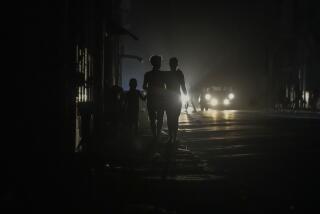Mexican officials blasted for handling of storms crisis
- Share via
MEXICO CITY – As the death toll continues to rise from twin storms that flooded much of Mexico, government officials are coming under intense criticism for their handling of the crisis, for failing to act on warnings, and for allowing shoddy construction that exacerbated the destruction.
Angel Aguirre, governor of Guerrero, the hardest-hit state, has been singled out for chastisement since it was revealed that he was at an all-night party with other politicians as the storm bore down on his state’s tourism gem, Acapulco, and numerous mountain villages that would be cut off for days and where the most people died.
“It rained and it rained, and the governor drank and drank,” read one particularly harsh headline in Proceso magazine, which carried a photograph of Aguirre arm-in-arm with his party partners before a festively decorated table and with a full mariachi band in the backdrop.
Aguirre has taken pains to make himself highly visible in rescue efforts and the distribution of aid. One photo showed him being interviewed by a journalist while standing waist-deep in floodwater.
Mexico was hit nearly two weeks ago by two storms that pounded its eastern and western coasts simultaneously: Tropical Storm Manuel, which did major damage to impoverished Guerrero and other Pacific states, and Hurricane Ingrid, which lashed Gulf Coast regions like Veracruz state.
According to the most recent figures released by the federal government Wednesday, 139 people were killed nationwide and at least 53 remained missing, most of these in the tiny village of La Pintada, in Guerrero, where a mudslide tore through the modest homes, burying everything and everyone in its path. Bodies are slowly being pulled from the mud, which is pushing the death toll higher even days after the worst rains stopped.
Mexican officials said September was on course to being the rainiest month in Mexican history. The twin storms spawned damage in 26 of Mexico’s 31 states; 312 “municipios,” or counties, were declared in a state of emergency and 250 in a state of disaster. The storms destroyed or crippled interstate highways, bridges, tunnels, schools and airports.
But the storms were not entirely to blame. Years of corruption, politically expedient building in geographically dicey locations, illegal logging that deforests much of the countryside and other abuses have rendered parts of Mexico especially vulnerable to the extreme whims of weather.
Plus, through generations of Mexican calamity, governments at all levels have routinely ignored or downplayed warnings, opting instead to take advantage of high-profile disaster relief operations that look good on camera.
No surprise there, columnist Jesus Silva-Herzog Marquez wrote this week, echoing a common refrain.
“We develop in unbuildable zones; we build with garbage; we design without planning,” he said. “Some do business, others die.”
The Mexican Senate demanded an investigation of the action officials took in preparing for and responding to the storms.
Aguirre, speaking this week at a nationally televised accounting of storm damage, broadcast from the National Palace in Mexico City, accepted no personal responsibility for failures. However, he acknowledged that political payoffs and other corruption have allowed the construction of housing projects and even fancy hotels in unsafe areas, such as the banks of frequently flooding rivers and dry lagoon beds.
One example of the problem was the Colosio neighborhood in Acapulco. While attention was focused on stranded tourists in the Pacific resort, the working-class community was devastated by flooding. Rain again forced evacuation of residents there Thursday, although the water had never never fully subsided. Residents could be seen hiking up their pants against water still at mid-thigh level as they walked out of the neighborhood, clutching a precious few belongings. The rain again forced the closure of the airport.
Sensitive to the criticism about early inaction, Interior Minister Miguel Angel Osorio Chong insisted that the government’s alert systems were sending out warnings to all states on Sept. 12, at least 24 hours before the storms made landfall.
But several officials have acknowledged that most of the alerts went out via Twitter or on the government’s websites, none of which would be available to Guerrero’s remote villages, where even electricity is a luxury.
“Hurricanes and earthquakes are the work of providence,” Alejandro Hope, a former member of the Mexican intelligence service and political analyst, commented Thursday. “But the calamities are our responsibility.”
ALSO:
War crimes court upholds 50-year sentence for Charles Taylor
Greenpeace activists, Moscow photographer placed under arrest
At Kenya’s request, Interpol issues alert for British ‘White Widow’
More to Read
Sign up for Essential California
The most important California stories and recommendations in your inbox every morning.
You may occasionally receive promotional content from the Los Angeles Times.











